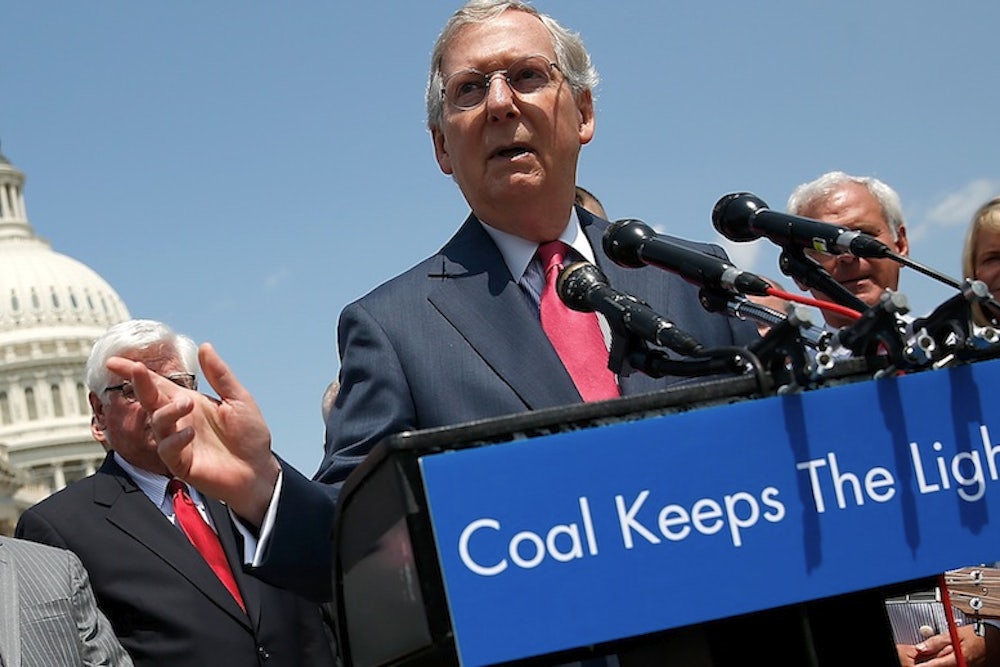Many of the attacks on President Barack Obama's signature program to slow climate change—the EPA’s Clean Power Plan—are no different from the coal industry's calibrated outrage of the last 40 years, which boils down to something like: the country is in for enormous rolling blackouts.
Butthe pro-coal side is also charging that the EPA is doing something actually illegal. On Wednesday, 15 Republican governors sent a letter to Obama claiming that the regulation "exceeds the scope of federal law." Coal-mining company Murray Energy and a dozen states have already filed lawsuits to take this argument to the courts. Congress probably won't be able to interfere withthe EPA's plan (that would involve amending the Clean Air Act), but the Supreme Court definitely could.
The letter echoes previous legal arguments against the regulation, making two main points: First, that the EPA can't regulate existing power plants because the Clean Air Act prohibits it. This seems like a strange argument, given that the Clean Air Act—specifically Section 111(d)—is what necessitates the EPA to act. In 2007, the Supreme Court ruled that greenhouse gasses could be regulated under the law, if the EPA determines they pose a threat to public health. But conservatives argue that existing power plants are already regulated under another section of the law, so Section 111(d) shouldn't apply. The EPA used this second section, Section 112, as the legal grounds for regulating mercury pollution from existing power plants.
Second, the letter argues that the EPA can't force states to regulate emissions beyond the point where they are emitted from power plants themselves. The EPA's proposal sets emissions targets for each state, and then allows the state to pursue a system for reaching that target, which it can do by increasing natural gas production, renewable energy, and energy efficiency. The letter says this shows the EPA has "overstepped this hypothetical authority when it acted to coerce states to adopt compliance measures that do not reduce emissions at the entities EPA has set out to regulate."
The Natural Resources Defense Council, which proposed a blueprint in 2012 similar to the EPA's plan, says there is nothing to worry about. NRDC Climate and Clean Air Program Director David Doniger said in an e-mail that arguments against that use of the ostensible limitations of the Clean Air Act "border on laughable." Section 111(d) applies when "existing sources emit a pollutant that is not addressed under other parts of the law," a responsibility shared between both the EPA and the states. When it comes to how EPA crafted the rule, the Clean Air Act states that the EPA should use the "best system of emission reduction." Doniger and the NRDC write that this includes a system that "plainly points toward a broad approach to cutting emissions," including implementing new coal plant pollution technology and renewable production, while also reducing demand through energy efficiency. The EPA has used a broad "beyond the fence" approach for other targets, as well, like when it set standards for trading nitrogen oxide credits in 1995.
"I am confident EPA will prevail on all these issues, including the fence-line issue, given the broad terms of the statute and the deference the Supreme Court indicated EPA deserves to solve new problems," Doniger said.
Environmentalists have watched for signs that the Supreme Court might agree with the EPA, or coal. After a string of legal victories, they seem optimistic. The EPA won a 6-2 decision in April that upheld its cross-state air pollution rule requiring states to clean up power plants that pollute across borders. But it is surely not the last time we'll be hearing from both sides about the legal justification for the EPA's plan.
